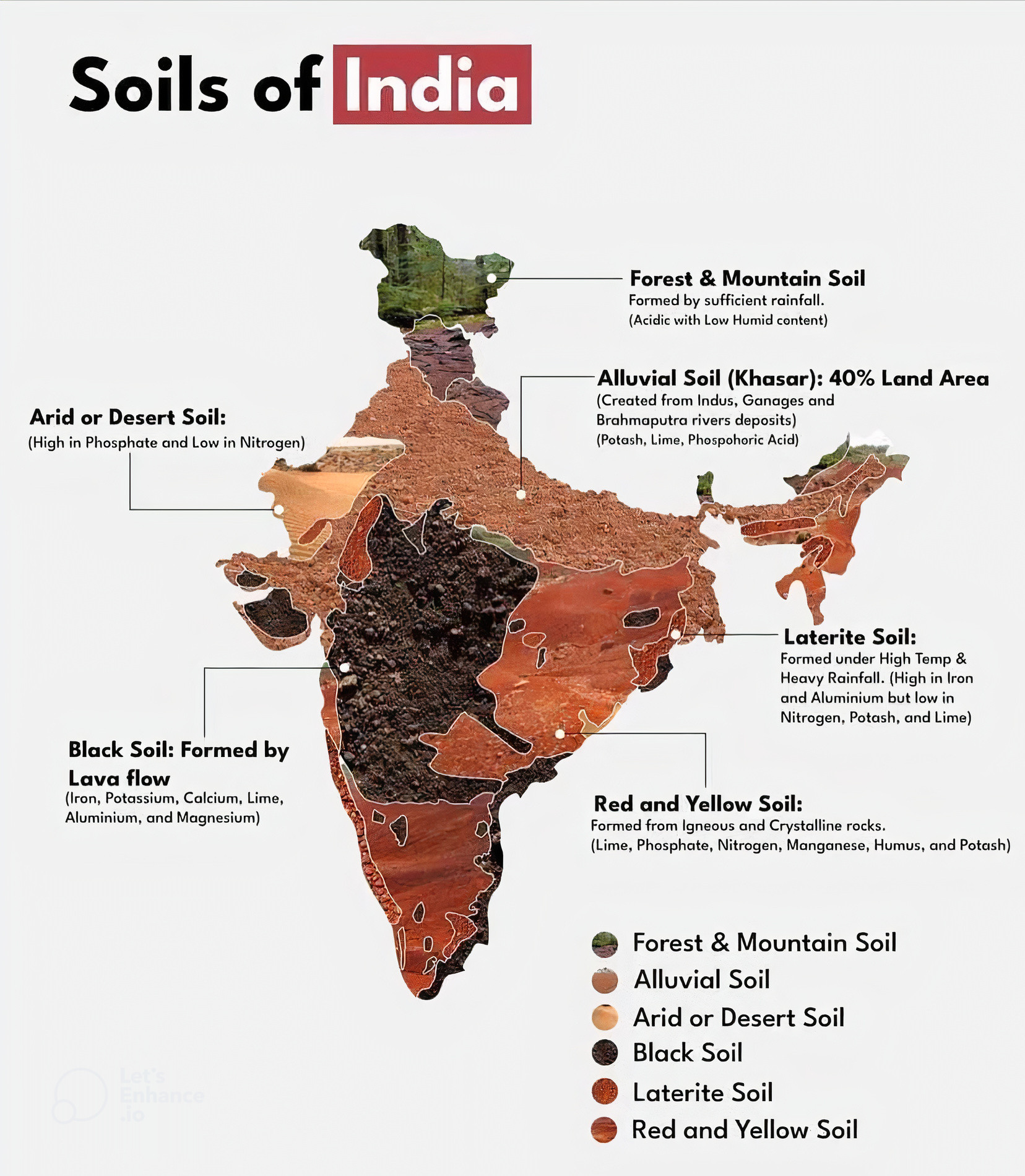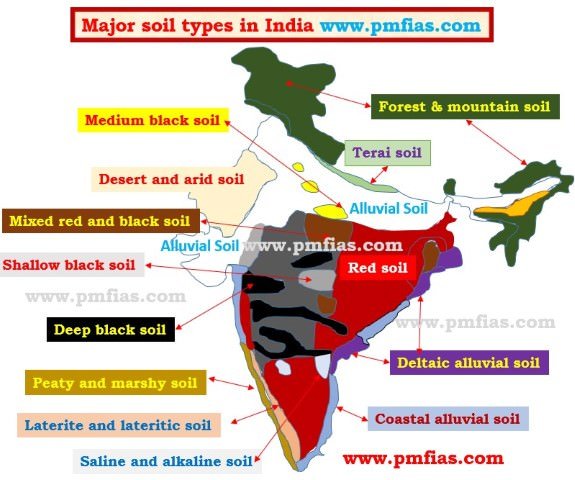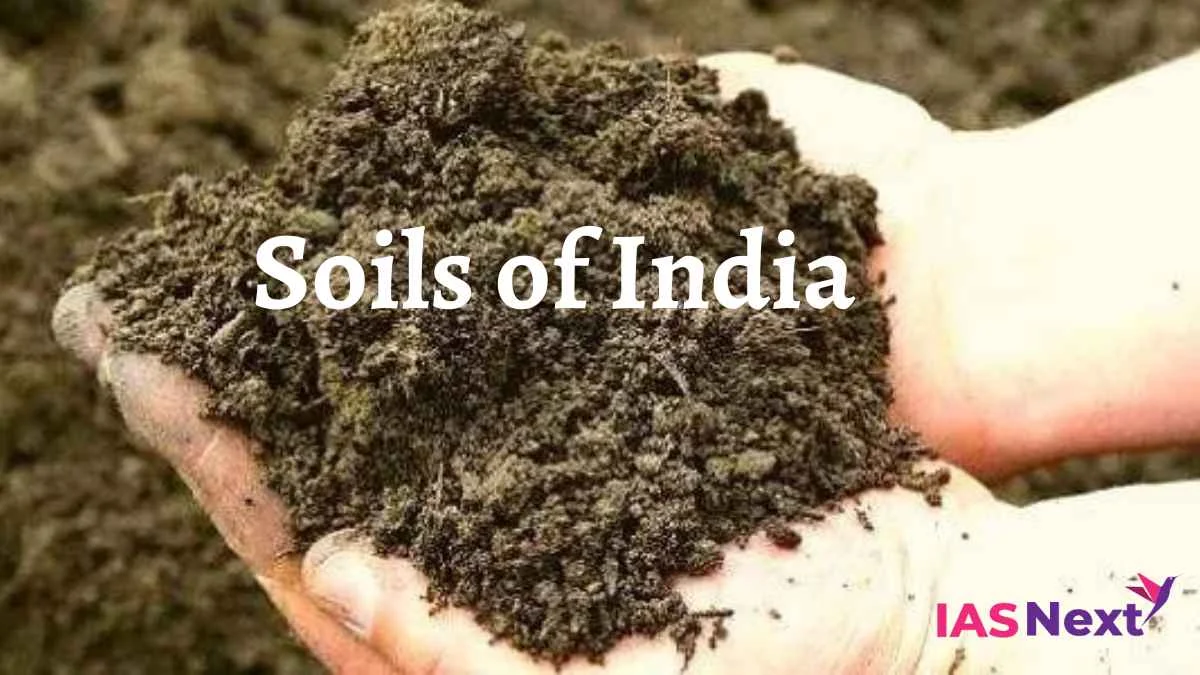SOILS OF INDIA

Soils in India display wide diversity because of the variations in the climate and relief. The soil forming components which include parent material, relief, climate and natural vegetation vary spatially.
The soil can be classified under various criteria, most acceptable being based on horizon development and its relationship with climatic condition.
Note:
1) The process of growing plants without the help of soil is called: Hydroponics
2) World Earth Day (Jubijishini) Day: April 22
3) Theme of 2021 World Earth Day: Restore Our Earth
4) World Wetland Day: February 2
5) The theme of 2022 World Wet Lands Day: “Wetlands Action for People and Nature.”
6) The word Soil is derived from Latin word Solum.
7) Solam is a suitable place for soil or soil / trees to live.
8) The method of studying the soil-Pedology
9) King Bhumibol World Soil Day-2020 Award for ICAR-Suchitra Durai
The following variables have an impact on soil formation:
These are the variables that influence how soil is formed:
1. Parent Resource:
Surface-exposed rocks weather to provide the parent material from which soils are created.
For example the soil derived from lava and rocks is generally black in colour.
2. Relief Features:
They influence the process of soil formation through various ways. The variation in relief features like slope, undergroun water etc. affect the colour, composition
and properties of soil.
3. Climate:
Climate is the most important single factor in soil formation. It affects the conditions of soil formation through the amount and seasonal distribution of
temperature and rainfall. It also affects soil formation indirectly by affecting other genetic factors like parent material. relief features, natural vegetation etc. 4. Natural Vegetation:
The decayed leaf material adds to the fertility of soil by providing to it the much needed content of humus. That is why the densely forested areas contain some of the best soils.

Soil Types:
The Indian Council of Agricultural Research (ICAR) has divided the Soils of India into 8 major groups.
1. Alluvial Solls including the coastal and deltaic alluvium:
Agriculturally the most important soil. It covers 24% of the country’s total area Mainly found in Central plains extending from Punjab to Assam, Eastern and Western Coastal
plains and deltaic region. Alluvial soil is transported or inter-zonal soil.
It is divided into Khadar (newer) and Bhabar (older) This soil is, how lus, deficient in nitrogen and humus content; unsuitable for water retentive plantation e.g. cotton.
it is suitable for the cultivation of rice, wheat, sugar cane and vegetables. Khadar: Finer and newer alluvium. Its texture varies from clayey to sandy loam.
It is light in colour and is formed in the flood-plains of rivers and
is generally acidic, deficient in lime, phosphorus and humus. Kankar:
They are found only few feets below the surface of Bhangar which is a bed of lime nodules known as kankar.
Kankars are collected near Dadri in Haryana for making cement.
Bhangar:
They are older alluvium or coarse gravel, high level soils above 30 m above flood level where flood water cannot reach.
Its texture is more clayey and the colour is darker.
Alluvial texture varies from sand and loam to silts and heavy clays that are ill drained and sometimes injurious accumulations of salt and produces a sterile surface called “Usar”.
In the sub-mountain belts on the foot hills of Siwalik alluvial forms with coarse often pebbly soils known as “Bhabhar”.
To its south occurs swampy lowland with silty soils known as “Terai”.
2. Black Cotton Soils:
Regur soil is another name for this. Deccan Trap is one of the main locations. Karnataka, Andhra Pradesh, Tamil Nadu, Maharashtra, Gujarat, Madhya Pradesh, Uttar Pradesh, and Rajasthan. Typically, black soils lack humus, phosphate, and nitrogen.
however abundant in magnesium, calcium, lime, aluminum, and potash. The soil has a high level of fertility and can hold onto moisture.
Growers can grow cotton, grains, oilseeds, citrus fruits, tobacco, and groundnuts there. Basalt-covered areas with semi-arid conditions are where black soils grow.
Deep black, light black, and chestnut are the several shades of black dirt. Since “Titani-ferous magnetite” is present, the black color is added.
With a large percentage of clay, they become sticky when wet, and in hot, sunny weather, they break.
3. Red Soils:
Occupies about 70% of the total area in Tamil Nadu, Chhotanagpur, few parts of Andhra Pradesh and Orissa
Red soils develop generally on crystalline and metamorphic rocks rich in ferro-magnesium
minerais. Hence they are more sandy and less clayey.
Red solis are found in area of comparatively low rainfall and so are less leached than the laterite soils.
Red soils have a concentration of iron, absence of lime, Kankar, carbonates, humus, phosphoric acid and are neutral to acid reactions.
They are not retentive to moisture so cultivated mostly during the rainy season. These are favourable for the cultivation of pulses and coarse grains.
Crops: Rice, Rags, Tobacco, Vegetables, Groundnut etc. on coarse soil for higher level; Sugarcane
on heavy clay at lower level.

courtsy: pmfias
4. Laterite Soils:
They are formed under the conditions of high rainfall and temperature with alternate wet and dry periods.
These soils are rich in oxides of iron and aluminum but poor in nitrogen, potash, phosphoric acid and lime content due to leaching, highly acidic in nature.
These soils are concentrated in Vindhyan Plateau, Satpura, Mahadeo and Maikal ranges in Madhya Pradesh, Malabar Coast, Orissa coast and Meghalaya.
Laterite soils develop in the tropical regions which receive heavy seasonal rainfall. Heavy rainfall promotes leaching whereby lime and silica are leached away and soils rich in
oxides of iron and aluminum are left behind.
If the oxide of aluminum predominates the laterite soils, they are called “Bauxite”, the chief
industrial ore of aluminum. Laterite soils are red due to the presence of oxides of iron.
They are poor in lime content hence acidic in nature. Laterite soils of high areas are very poor and least retentive to moisture.
Sometimes they form the barren land topography
Laterite soils of low level areas hinder the process of laterization due to regular addition of soil washed down from the neighbouring high areas. Crops: Rice, Ragi, Sugarcane, Tapioca, Chestnut etc.
5. Forest Soils:
Humus predominates in forest soil but it is deficient in potash, phosphorous and lime.
It is distributed over the Himalayan and other ranges in the north, Western Ghats, Eastern Ghats and Peninsula.
Favourable for plantation crops e.g. tea, coffee spices and tropical fruits. 1. Podzols (At high Level):
They are formed under high acidic condition and found on
higher slopes of Himachal Pradesh and Jammu & Kashmir. They are covered by coniferous forests. They are highly leached due to excessive moisture and are grayish brown in colour.
2. Brown Forest Soil (In warm temperate belt):
They are less acidic than podzol with high base status. They are rich in humus and fertile and extensively used for crop cultivation.
3. Alpine Meadow (In alpine zone of Himalayas): They are dark coloured, either sandy-clay or sandy-loam.
They contain mostly undecomposed plants.
6. Arid and Desert Soils :
These soils, characterized by high salt and low humus content, are found in Rajasthan, Haryana, Punjab, Rann of Kutch, and other rain-shadow regions, since these soils consist of high phosphate.
fertility increases with irrigation and by adding nutrients. Desert soils are found in an arid and semiarid conditions
in northwestern part of India, west of Aravalli range.
They are mostly friable and low in moisture content They are rich in phosphate but poor in nitrogen and clay content
Crop: Very few crops especially Millets, Jowar, Bajra are grown for want of water supply.
7. Saline and Alkali Soils:
Develop along arid region in small patches. Also called Reh, Kallar and Usar, they are infertile but can be reclaimed by good drainage.
These soils are found in Rajasthan, Punjab, Haryana, U.P. and Bihar.
Saline and alkaline soils develop at places where desert condition prevails because of high rate
of evaporation and very little leaching. Saline soils contain free sodium and other salts while alkaline soils have sodium chloride .
Alkaline soils are deficient in calcium and nitrogen and are highly impervious and have very low water holding capacity. Crops: Rice, wheat, cotton, sugarcane, tobacco etc.
supported by irrigation. For better fertility application of lime and gypsum and cultivation of salt resistant crops like berseem, rice, sugarcane can be used.
8. Peaty and Organic Solls:
Develop under result of accumulation of large quantity of organic matter. Highly saline and deficient in phosphate and potash and occur in central Orissa, Central Bihar, West Bengal and Tamil Nadu.
Peaty and Marshy soils originate in humid regions as a result of an accumulation of large amount of organic matters.
They may contain considerable soluble salt and is called as “Kari”. These areas are submerged under water during the monsoon season and as soon as rain ceases the land is put under paddy cultivation.
These soils are black, heavy and highly acidic.
Soil Erosion:
The destruction of soil cover is known as soil erosion.
The main reasons of soil erosion are:
a) Deforestation
b) Over-grazing
c) Irrational cultivation (e.g., Jhoom cultivation in North Eastern India)
d) Floods
e) Winds
Soil Erosion in India:
In general, tracts with little vegetation cover, such as the Yamuna and lower Chambal badlands, are the locations in India that have experienced soil erosion. Because there is little to no vegetation in these places, flowing water can quickly sever the earth, creating deep ravines.
The plain has comparable erosion in several areas due to a significant degree of slope. Conversely, wind erosion causes the arid regions of Rajasthan and Haryana to lose their soil cover.
Preservation of Soil:
Conservation of soil is impacted by the current environment.
However, the most widely used methods are contour cultivation, afforestation, and scientific agricultural methods that consider the characteristics of the terrain.
Soils that lack lime are the result of rainwater washing away the calcium compounds.
These acidic soils form in regions that receive a lot of rainfall.




